It’s important to note that the ideal duration for your Kyushu trip depends on your specific interests and the activities you want to include in your itinerary. Some travelers might find that a shorter or longer duration suits their preferences better. When planning your trip, consider the places you want to visit, the activities you want to do, and how much time you want to spend at each location to tailor the itinerary to your liking.
We will be going around Kyushu in a clockwise direction for this visit. As Kyushu is quite a big island, the best way to do it is by means of a rental car. Although trains and buses are able to bring you to many of the popular sites, the time taken and the effort will greatly reduce the number of places you can visit.
Let’s roll.
Day 1 – Beppu
Nanzoin

This Buddhist temple, founded in the eighth century, has evolved into a serene haven that attracts visitors worldwide.
At the heart of Nanzoin lies the colossal bronze statue of the reclining Buddha, commonly known as the “Nanzo-in Daibutsu.” This majestic sculpture, stretching an impressive 41 meters in length, is renowned as one of the largest bronze statues in the world. The serene countenance of the Buddha imparts a sense of peace and contemplation, inviting visitors to immerse themselves in the spiritual ambiance of the temple.





The temple grounds are adorned with lush greenery, cherry blossoms, and meandering pathways, creating an atmosphere of natural harmony. Visitors can traverse through tranquil gardens and explore various prayer halls and meditation spaces, each contributing to the holistic experience of Nanzoin. The intricate details of the architecture, with its traditional Japanese aesthetic, reflect a deep respect for Buddhism’s cultural and historical roots in the region.
Nanzoin is not merely a religious site but a cultural treasure trove. The temple hosts various events and rituals throughout the year, allowing visitors to witness and partake in the rich tapestry of Buddhist traditions. Pilgrims and tourists find solace in the temple’s serene ambiance, making it a popular destination for those seeking spiritual enlightenment and cultural immersion.
Dazaifu Tenmangu

Located in Dazaifu City, Fukuoka Prefecture, this sacred site is dedicated to Sugawara Michizane, a renowned scholar, poet, and politician from the Heian period.
The shrine’s history traces back to 919 AD when it was established, and over the centuries, it has become a revered destination for scholars and students seeking blessings for academic success. Michizane, often deified as Tenjin, the kami of learning, art, and calligraphy, is enshrined here, creating an atmosphere that resonates with a deep sense of intellectual pursuit.
Dazaifu Tenmangu’s architectural splendor is evident in its vermilion-hued structures, intricate wooden carvings, and a mesmerizing bridge that spans a reflective pond. The entrance is marked by the Romon Gate, a grand structure that sets the tone for the spiritual journey within. The path leading to the main hall, Honden, is adorned with stately stone lanterns and majestic camphor trees, casting an ethereal ambiance.
One of the shrine’s distinctive features is the “Uguisu-bari” or nightingale floor, a historic wooden walkway that emits melodic chirping sounds reminiscent of a nightingale’s song as visitors tread upon it. This auditory experience adds a poetic touch to the pilgrimage, transporting visitors to a bygone era.
Throughout the year, Dazaifu Tenmangu hosts vibrant festivals, including the Plum Blossom Festival in February, celebrating the blooming of thousands of plum trees that grace the shrine’s grounds. The Ume Matsuri attracts locals and tourists alike, creating a lively atmosphere filled with cultural performances and traditional rituals.
Book and Save with this Dazaifu Shrine, Yufuin, and Beppu One-Day Tour from Fukuoka.
杷木大ひまわり園



杷木大ひまわり園 (Hamaki Dai-Himawari En) is a vibrant sea of golden hues that captivates visitors with its breathtaking beauty. Spread across expansive fields, this sunflower garden is a seasonal spectacle that typically blooms during the summer months, transforming the area into a radiant paradise.
As visitors wander through the 杷木大ひまわり園, they are greeted by rows upon rows of sunflowers, their cheerful faces turning towards the sun. The air is filled with the sweet scent of blooming flowers, creating a sensory experience that adds to the enchantment of the surroundings. The vastness of the sunflower field provides ample opportunities for visitors to immerse themselves in the natural splendor, offering countless photo-worthy moments against the stunning backdrop of the Kyushu countryside.
The best period to visit is in September.
Please check https://amagiasakura.net/sightseeing_post/hakidaihimawarien/ for the latest update.
Farm Station Basallo



The Roadside station ‘Harazuru’ Farm Station Basallo is across the sunflowers field.
This roadside station seamlessly blends traditional Japanese hospitality with modern amenities, making it a must-visit for locals and travelers alike.
As you approach the station, the welcoming sight of vibrant flower beds and neatly manicured gardens greets you, setting the tone for a serene and relaxing experience. Harazuru takes pride in showcasing the region’s agricultural bounty, with a diverse array of fresh produce, artisanal crafts, and local delicacies available for purchase.
One of the station’s highlights is its sprawling farmers’ market, where visitors can immerse themselves in the vibrant colors and fragrances of locally grown fruits, vegetables, and flowers. The station’s commitment to supporting local farmers and businesses is evident in the carefully curated selection of products, ranging from seasonal fruits to handmade crafts.

We strongly recommend the Green Shin Muscuot Grapes which are deliciously sweet and crispy.
Ukiha-Inari Shrine


A hillside shrine with views over the Chikugo Plain, accessed via a steep avenue of red torii gates.
For those driving, you can drive all the way up to the top of the hill instead of walking.
Marvel at the scenery before you and take in the fresh air.
Yufuin Floral Village





This enchanting village is located in Yufu City, Oita Prefecture, renowned for its hot springs and stunning vistas of Mount Yufu. Yufuin Floral Village stands out as a unique attraction, offering visitors a delightful escape into a world of blooming flowers, artistic displays, and serene surroundings.
As you enter the village, you are greeted by a kaleidoscope of colors from the myriad of flowers that adorn the landscape throughout the seasons. From vibrant tulips in spring to delicate lavender fields in summer, the floral displays create a visually stunning panorama that changes with the rhythm of nature. The carefully landscaped gardens and walking paths invite visitors to meander through the beauty, providing a tranquil and immersive experience.
Beyond the natural allure, Yufuin Floral Village boasts a distinctive artistic atmosphere. The village is dotted with charming shops and boutiques that showcase local craftsmanship and creativity. Visitors can explore a variety of artisanal products, from handmade pottery to unique floral-themed souvenirs. The integration of art and nature creates a harmonious ambiance, making it a haven for those seeking both aesthetic pleasure and cultural enrichment.
A highlight of Yufuin Floral Village is its iconic Windmill Plaza, where a grand Dutch-style windmill stands proudly against the backdrop of Mount Yufu. The plaza offers panoramic views of the surrounding countryside and is a popular spot for visitors to capture the essence of the village.
Book and Save with this Dazaifu Shrine, Yufuin, and Beppu One-Day Tour from Fukuoka.
Kinrin Lake

This enchanting lake, often referred to as “Kinrinko,” is a jewel in the region, captivating visitors with its natural beauty and tranquil ambiance.
The lake, formed by the eruption of Mount Yufu thousands of years ago, spans approximately 27,000 square meters and is renowned for its crystal-clear waters. Its name, Kinrin, translates to “golden scales,” a fitting appellation derived from the shimmering reflections of the surrounding landscape on the water’s surface, particularly during sunrise and sunset.
Flanked by a scenic walking path, the lake invites visitors to stroll along its shores, offering uninterrupted views of the Yufu mountains and the changing seasons. Cherry blossoms paint the area in delicate hues during spring, while vibrant foliage adorns the landscape in autumn, creating a kaleidoscope of colors. The park surrounding Kinrin Lake features well-maintained gardens, inviting benches, and charming bridges that enhance the overall tranquility of the setting.
One of the lake’s distinctive features is the floating torii gate, a symbol of spiritual significance in Japanese culture. Positioned at the entrance of the lake, the torii gate adds a touch of mystique to the surroundings, inviting contemplation and reflection.
Kinrin Lake is not only a visual delight but also a source of geothermal activity. On the lake’s western shores, steam rises from hot springs, creating an ethereal atmosphere. Travelers can immerse themselves in local traditions by indulging in foot baths scattered around the area, allowing them to relax while taking in the breathtaking scenery.
Book and Save with this Dazaifu Shrine, Yufuin, and Beppu One-Day Tour from Fukuoka.
Day 2 – Oita
Umi Jigoku





Umi Jigoku is one of the eight hells that make up the famous Jigoku Meguri, or Hell Tour, offering visitors a unique and surreal experience.
The distinctive hue of the Umi Jigoku’s waters is a result of high mineral content, primarily copper sulfate, which imparts an intense blue color to the geothermal pool. The striking contrast of the azure water against the surrounding landscape creates a mesmerizing and almost surreal sight that captivates the imagination. The steaming water bubbles up from the depths of the earth, reminding visitors of the powerful geological forces at play beneath the surface.
Beyond its vivid aesthetics, Umi Jigoku also features a range of attractions that enhance the overall experience. The area is adorned with well-maintained gardens, showcasing the harmonious integration of nature and man-made elements. Visitors can stroll along pathways lined with vibrant flowers and ornamental plants, creating a tranquil and immersive atmosphere.

Furthermore, Umi Jigoku boasts a foot bath where weary travelers can soak their feet in the warm, mineral-rich waters while taking in the breathtaking scenery. The therapeutic properties of the water add a rejuvenating touch to the overall visit, making it not only a visual feast but also a sensory delight.
Jigoku Mushi





This renowned restaurant, translating to “Hell Steaming” in English, takes its name from the region’s famous hot springs, known as “Jigoku” or “Hells,” which serve as a testament to the volcanic activity that shapes Kyushu’s rugged terrain.
Jigoku Mushi’s culinary concept revolves around the ancient Japanese tradition of steam cooking, a method that harnesses the natural geothermal energy abundant in Kyushu. The restaurant’s setting is a harmonious union of contemporary design and the rustic charm of the surrounding landscape, providing a tranquil backdrop for the gastronomic journey that awaits patrons.

The menu at Jigoku Mushi is a carefully curated symphony of flavors, showcasing the region’s finest seasonal ingredients. From locally sourced vegetables to the freshest seafood, each dish is a testament to the restaurant’s commitment to culinary excellence. Signature dishes include delicate sashimi steamed to perfection, bringing out the natural essence of the ingredients, and hearty hot pots that simmer with the essence of Kyushu’s rich culinary heritage.

Best of all, you get to cook your own food.
The dining experience at Jigoku Mushi is elevated by the attentive and knowledgeable staff, who guide guests through the menu with warmth and expertise. The restaurant’s commitment to sustainability is evident not only in its locally sourced ingredients but also in its eco-friendly practices, creating a dining experience that is as mindful as it is indulgent.
Nabegataki Falls

Located in the small town of Oguni, Nabegataki Falls is a hidden gem, often overlooked by the bustling urban centers. The falls, with a height of approximately 10 meters and a width of 20 meters, cascade gracefully over a semicircular cliff, creating a mesmerizing curtain of water that captivates the senses. What sets Nabegataki apart is its unique horseshoe-shaped formation, allowing visitors to walk behind the falls and experience an immersive and intimate connection with the cascading water.
Surrounded by dense forests and a profusion of vibrant flora, the journey to Nabegataki Falls is as much a part of the experience as the destination itself. The hiking trails leading to the falls are adorned with a tapestry of seasonal colors, providing a visual feast for nature enthusiasts. Visitors can also relish the melodic sounds of birdsong and the gentle rustling of leaves as they traverse the scenic paths.
The falls undergo a magical transformation with each season, from the lush greenery of spring and summer to the vibrant hues of autumn foliage. Winter transforms the landscape into a serene, icy wonderland, adding yet another layer of allure to Nabegataki’s charm.
Daikanbo, Yamada

This scenic overlook, situated in the Aso-Kuju National Park, stands as a testament to the natural beauty and geological wonders that define the region. The name “Daikanbo” translates to “platform with a grand view,” and it lives up to its moniker by providing visitors with an awe-inspiring spectacle of the Aso caldera.
The Aso caldera is a colossal volcanic crater, one of the largest in the world, formed by the ancient eruption of Mount Aso. Daikanbo is strategically located on the northern rim of this immense crater, granting visitors an unparalleled glimpse into its expansive interior. The panoramic vista includes the undulating hills, verdant plains, and the iconic peaks of the surrounding mountains.
One of the distinguishing features of Daikanbo is its accessibility. Visitors can reach this lofty vantage point by car or bus, ascending through winding mountain roads that enhance the anticipation of the scenic reward awaiting them at the summit. Upon arrival, a spacious observation deck provides a perfect perch for soaking in the natural splendor, making it an ideal spot for photography enthusiasts, nature lovers, and those seeking a serene escape.
Beyond the visual feast, Daikanbo also serves as a starting point for various hiking trails that weave through the Aso-Kuju National Park. These trails cater to different skill levels, offering opportunities for exploration and a closer encounter with the diverse flora and fauna that thrive in this volcanic region.
Kusasenri



At the heart of Kusasenrigahama lies a vast, open grassland surrounded by the Aso volcanic caldera, one of the largest in the world. The landscape is dominated by lush greenery, where grassy plains extend as far as the eye can see, creating a tranquil and idyllic atmosphere. The majestic backdrop of the surrounding mountains, including the iconic Mount Aso with its active volcanic crater, adds a touch of drama to the scenery, making Kusasenrigahama a truly awe-inspiring destination.
One of the unique features of Kusasenrigahama is its resident population of Akaushi cattle, a Japanese breed known for its gentle demeanor and marbled beef. These cattle graze freely on the grassy plains, providing a picturesque pastoral scene that captures the essence of rural Japanese life. Visitors can often witness the harmonious coexistence of these animals with the natural environment, creating a sense of tranquility that is both calming and immersive.
Beyond its natural beauty, Kusasenrigahama holds cultural significance, with historical ties to the ancient practice of horse racing known as “Yabusame.” The vast plains served as a venue for this traditional equestrian event, where skilled archers showcased their prowess while riding at high speeds. Today, Kusasenrigahama stands as a testament to the enduring connection between nature and culture, offering visitors a chance to immerse themselves in the timeless charm of Kyushu’s landscape.
Mount Aso





Mount Aso’s claim to fame lies in its colossal caldera, a vast crater formed by a series of volcanic eruptions that occurred thousands of years ago. The caldera, measuring approximately 25 kilometers in diameter, encircles a diverse and dynamic landscape that beckons adventurers and nature enthusiasts alike. At its center, the active volcanic peaks of Mount Aso rise dramatically, emitting plumes of steam that paint the sky with an ever-changing canvas of clouds. The sight of the active crater, Nakadake, provides a thrilling glimpse into the Earth’s restless energy.
Surrounding the volcanic expanse, lush greenery carpets the slopes, creating a picturesque setting that transitions with the seasons. Cherry blossoms bloom in spring, adding a touch of pink to the verdant landscape, while autumn transforms the mountainside into a fiery tapestry of red and gold. The juxtaposition of the vibrant flora against the rugged volcanic terrain creates a visual symphony that captivates visitors throughout the year.
Apart from its breathtaking natural beauty, Mount Aso holds cultural significance deeply rooted in Japanese history and mythology. The surrounding Aso region is home to traditional farming communities, charming villages, and historic shrines, providing a glimpse into the harmonious coexistence of human life and the powerful forces of nature.
Takachiho Gorge

Carved over millennia by the Gokase River, this picturesque gorge is renowned for its steep cliffs, emerald-green waters, and lush vegetation that create a serene and enchanting atmosphere.
The gorge holds a special place in Japanese mythology, as it is believed to be the setting for the divine couple, Izanagi and Izanami, who, according to legend, created the islands of Japan and gave birth to numerous gods. The spiritual ambiance of Takachiho Gorge is heightened by the surrounding ancient cedar trees and moss-covered rocks, contributing to its status as a sacred site.
Visitors to Takachiho Gorge can embark on a mesmerizing boat ride along the gently flowing river, allowing them to marvel at the towering cliffs that rise dramatically on either side. The experience is particularly enchanting during the fall season when the foliage transforms into a vibrant tapestry of red, orange, and gold hues, casting a magical spell over the landscape.
A highlight of a visit to Takachiho Gorge is the stunning Manai Falls, a 17-meter waterfall that cascades gracefully into the gorge below. The sight and sound of the waterfall, combined with the verdant surroundings, create a sensory spectacle that leaves an indelible impression on all who witness it.
Takachiho Gorge is not only a natural marvel but also a cultural treasure, as the nearby Takachiho Shrine hosts traditional Kagura performances. Kagura is a form of Shinto theatrical dance that recounts ancient myths and rituals, providing visitors with a deeper connection to the region’s rich cultural heritage.
Book and Save with the Miyazaki One-Day Tour from Fukuoka with Japanese Beef Lunch.
Day 3 -Miyazaki
Atagoyama Lookout


Perched atop Atagoyama, a prominent hill in the heart of Kyushu, this scenic vantage point offers visitors a captivating panorama of the surrounding landscape, inviting them to immerse themselves in the splendor of Japan’s diverse terrain.
The journey to Atagoyama Lookout is an experience in itself, as visitors navigate through lush forests and winding paths that gradually unveil the breathtaking views that await at the summit. The ascent is not only a physical journey but also a cultural one, with the hill holding historical significance and often adorned with shrines and monuments that speak to the spiritual heritage of the region.

As visitors reach the pinnacle of Atagoyama, they are rewarded with a sweeping vista that captures the essence of Kyushu’s natural grandeur. Rolling hills, dense forests, and perhaps even a glimpse of distant mountains paint a canvas that changes hues with the shifting sunlight, providing a spectacle that varies with the seasons. From cherry blossoms in spring to vibrant foliage in autumn, Atagoyama Lookout offers a kaleidoscope of colors throughout the year.
Beyond its natural allure, Atagoyama Lookout serves as a place of tranquility and reflection. The serene atmosphere encourages visitors to pause, breathe in the crisp mountain air, and absorb the profound sense of peace that permeates the surroundings. For those seeking a respite from the hustle and bustle of urban life, this lookout provides a sanctuary to reconnect with nature and oneself.
Heiwadai Park
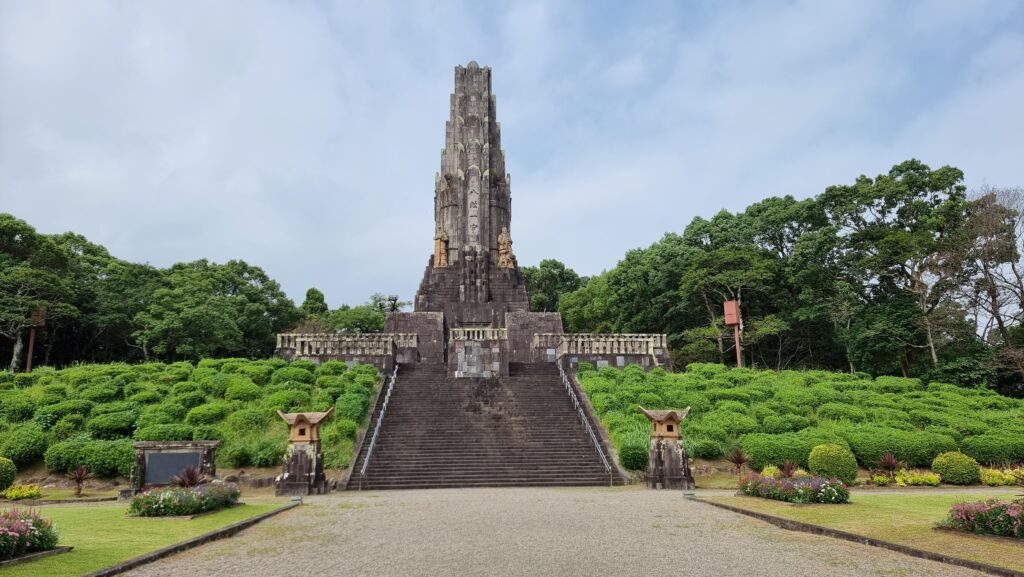
Renowned for its picturesque landscapes and cultural significance, the park is a testament to Japan’s commitment to peace and harmony. Heiwadai, which translates to “Peace Tower,” is a fitting name for this verdant sanctuary that not only captivates visitors with its lush greenery but also serves as a symbol of the nation’s enduring pursuit of peace.
The park’s focal point is the Heiwadai Tower, a majestic structure that commands attention with its imposing presence. Built in 1942, the tower was initially constructed to celebrate the 2600th anniversary of Japan’s imperial era. Today, it stands as a symbol of peace and a reminder of the nation’s resilience through historical challenges. Visitors to Heiwadai Park can ascend the tower and enjoy panoramic views of the surrounding landscape, offering a unique perspective on the juxtaposition of nature and history.

Step in front of this plate and clap your hand, you will hear an echo from the tower.
Wandering through the park, one encounters meticulously manicured gardens, ponds adorned with water lilies, and meandering pathways that invite contemplative strolls. Cherry blossoms in spring and vibrant foliage in autumn add seasonal splendor to the already enchanting scenery, creating a kaleidoscope of colors that reflects the changing rhythms of nature.
Miyazaki Jingu
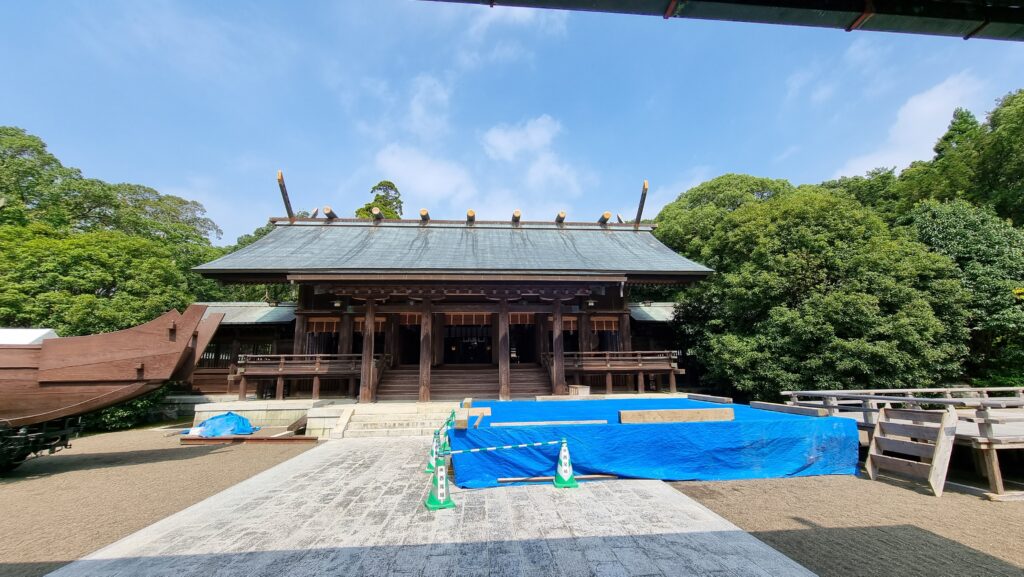
Miyazaki Jingu is a revered Shinto shrine that stands as a testament to the rich cultural and spiritual heritage of the region. Steeped in history, this sacred site is dedicated to the deified spirits of Emperor Jimmu and Empress Jingu, mythical figures in Japanese legend who are considered the progenitors of the imperial lineage.

The shrine’s architecture is a captivating blend of traditional Japanese design and intricate details that reflect the deep respect for nature and spirituality in Shinto beliefs. Approach the sacred grounds through the picturesque Torii gate, an iconic symbol marking the transition from the mundane to the divine. The serene atmosphere enveloping Miyazaki Jingu is enhanced by the lush greenery that surrounds it, creating a tranquil oasis amidst the bustling city.
The annual Aoba Matsuri, held at Miyazaki Jingu, is a vibrant celebration that attracts visitors from far and wide. This lively festival, dedicated to the shrine’s deity, features colorful processions, traditional performances, and a lively market, offering a unique opportunity to immerse oneself in the local culture.
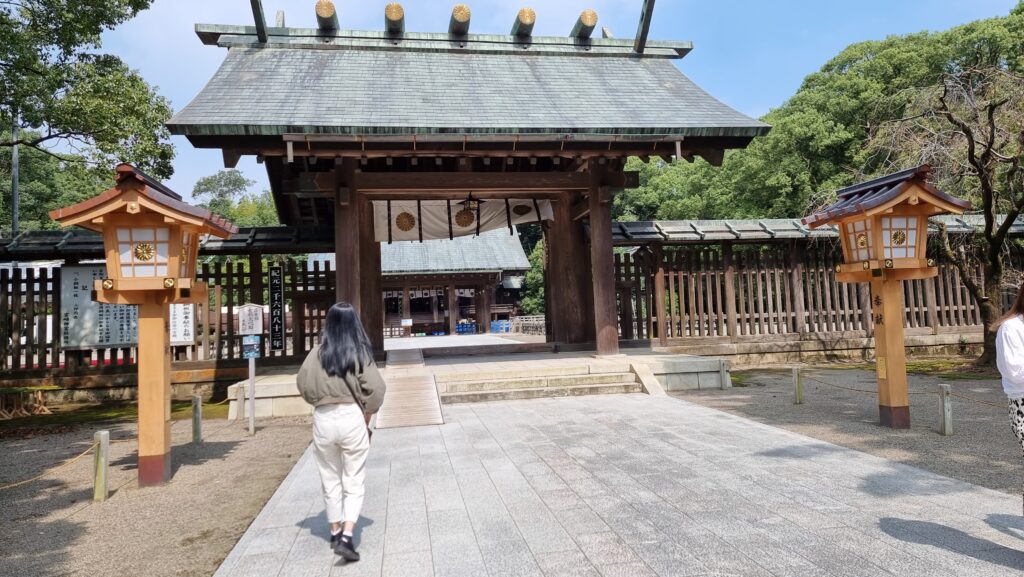
Beyond its religious significance, Miyazaki Jingu holds a special place in the hearts of locals as a symbol of community and tradition. Visitors can witness the rhythmic rituals performed by priests, experience the profound spiritual ambiance during ceremonies, and explore the beautifully landscaped grounds, including the sacred forest that adds an ethereal dimension to the shrine.
Obi Castle Ruins



Perched atop a strategic hill, the castle ruins offer a captivating glimpse into Japan’s feudal past, immersing visitors in the architectural splendor and strategic significance of this once-mighty fortress.
Constructed in the late 16th century during the Warring States period, Obi Castle played a crucial role in the tumultuous political landscape of medieval Japan. Originally built by the powerful warlord Otomo Sorin, the castle underwent subsequent expansions and renovations, reflecting the evolving dynamics of the time. The site’s commanding position provided not only a formidable defense against potential invaders but also offered sweeping panoramic views of the surrounding landscape.
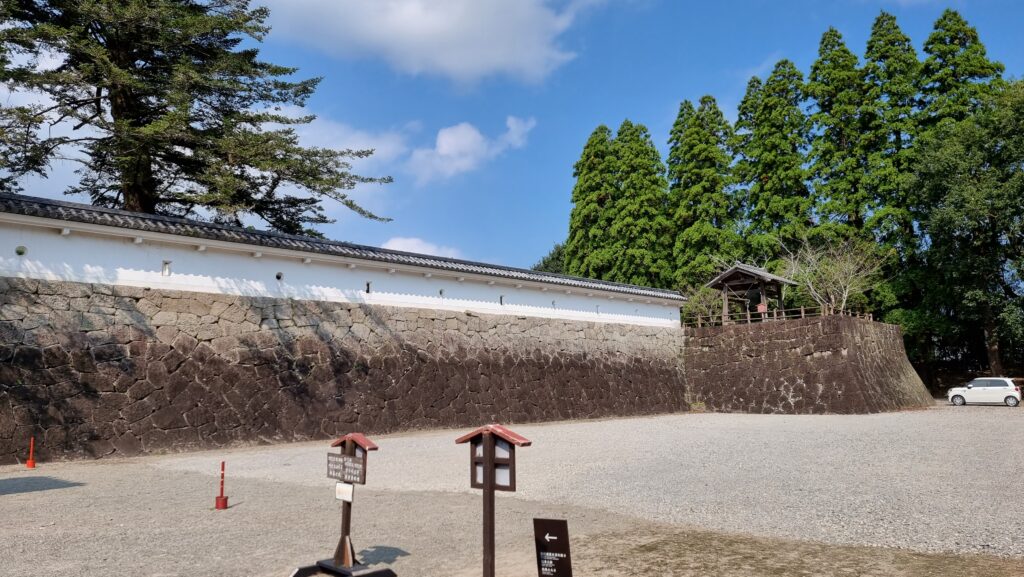
While the castle itself no longer stands, its ruins encapsulate a profound historical narrative. Visitors can explore the remnants of stone walls, foundation stones, and other architectural features that whisper tales of samurai warriors, political intrigue, and the ebb and flow of power. The castle grounds also boast a meticulously curated garden, blending the beauty of nature with the remnants of human ingenuity.
As visitors traverse the castle grounds, they encounter various structures such as the Otemon Gate, which once served as the main entrance, and the Ninomaru Goten, a reconstructed palace that provides insight into the luxurious lifestyle of the ruling elite. The immersive experience is further enriched by informative exhibits and displays within the site’s museum, shedding light on the historical context and significance of Obi Castle.
Udo Jingu

Nestled in a coastal cave overlooking the Pacific Ocean, this sacred site holds great significance in Japanese mythology and history. The shrine is dedicated to Ugayafukiaezu, a mythical figure considered the father of Japan’s first emperor, Emperor Jimmu.
What makes Udo Shrine particularly captivating is its stunning natural setting. Carved into the rocky cliffs, the shrine’s location provides breathtaking views of the ocean and surrounding landscapes. Pilgrims and tourists alike visit the shrine to pay their respects, enjoy the spiritual atmosphere, and take in the awe-inspiring scenery.
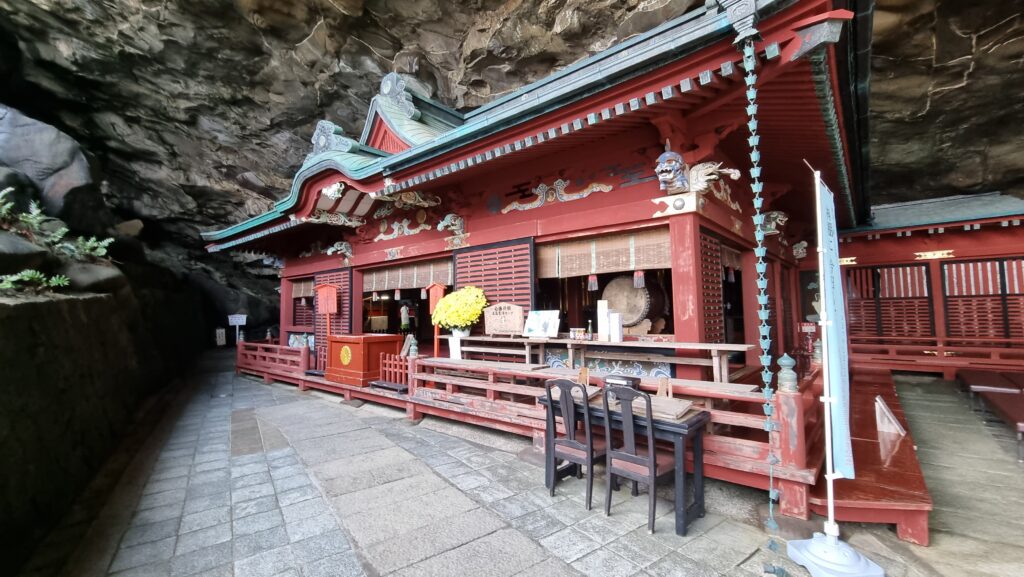
The main hall of Udo Shrine, perched within the cave, adds a sense of mystique to the spiritual experience. Visitors can witness the rhythmic crashing of waves against the cliffs while exploring the shrine’s grounds, contributing to a serene and contemplative ambiance.
Udo Shrine also plays a role in local traditions and festivals, making it a cultural hub in the region. Pilgrims often visit during Hatsumode (the first shrine visit of the New Year) to seek blessings for the coming year. Overall, Udo Shrine in Kyushu stands as a testament to the rich cultural and natural tapestry that characterizes Japan’s diverse landscapes.
Sun Messe Nichinan

Renowned for its stunning coastal landscapes, temperate climate, and cultural richness, Sun Messe Nichinan stands out as a unique blend of natural beauty and artistic expression. This enchanting site offers visitors a multifaceted experience, seamlessly weaving together history, art, and the awe-inspiring beauty of the surrounding environment.

At the heart of Sun Messe Nichinan is the iconic Sun Messe Nichinan Pyramid, a striking structure that mirrors the architectural grandeur of the ancient pyramids of Egypt. This pyramid serves as a symbol of the strong cultural ties between Japan and Egypt, celebrating the enduring spirit of friendship and cooperation. As visitors approach the pyramid, they are greeted by an expansive view of the Pacific Ocean, adding a touch of tranquility to the overall experience.

One of the standout features of Sun Messe Nichinan is its outdoor sculpture park, which showcases a remarkable collection of art installations set against the backdrop of lush greenery and the azure sea. These sculptures, created by both Japanese and international artists, contribute to the park’s dynamic and ever-evolving artistic landscape.
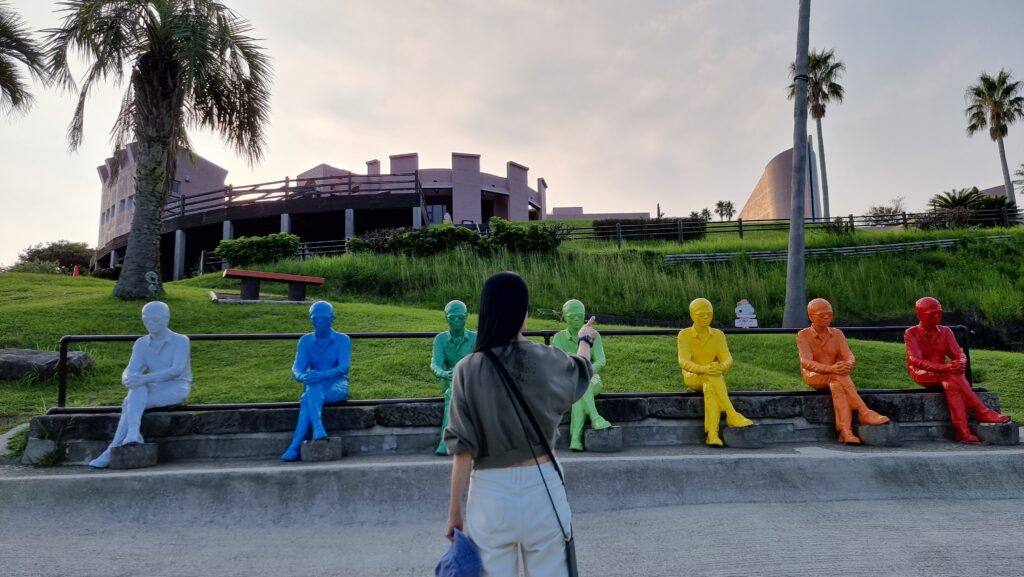
Furthermore, the site pays homage to the cultural heritage of Kyushu through various exhibitions and events that highlight the rich history and traditions of the region. Visitors can explore exhibitions on local crafts, traditional performances, and interactive displays that provide a deeper understanding of Kyushu’s cultural tapestry.
Aoshima Island/Shrine



Aoshima Shrine, nestled on the picturesque Aoshima Island in Miyazaki Prefecture, Kyushu, Japan, is a sacred haven that seamlessly blends natural beauty with spiritual significance. The shrine stands as a testament to the harmonious relationship between Japanese Shinto beliefs and the awe-inspiring landscapes that define the region.
Approaching Aoshima Island, visitors are greeted by the iconic Aoshima Bridge, a gateway to a realm where the spiritual and the natural converge. The shrine, dedicated to the deity Ichihime-no-kami, is renowned for its association with love and matchmaking. Couples seeking blessings for their relationships often make pilgrimages to this serene sanctuary, surrounded by the gentle whispers of the Pacific Ocean.
One of the most distinctive features of Aoshima Shrine is the “Married Couple Rocks” or “Meoto Iwa,” two sacred rocks connected by a sacred Shimenawa rope, symbolizing the union of husband and wife. This natural formation serves as a powerful representation of the enduring strength and unity within marriage, drawing couples from far and wide to partake in rituals that affirm their love.
Aoshima Island itself is a marvel of nature, boasting lush subtropical vegetation, ancient trees, and captivating caves. The combination of the shrine’s sacred architecture and the island’s enchanting surroundings creates a mystical ambiance that captivates the senses.
Day 4 – Kagoshima
Mizonokuchi-Cave

Situated in the heart of the Kirishima-Yaku National Park, Mizunokuchi Cave is a geological marvel formed over millions of years through the slow and patient work of water on volcanic rock. The cave’s name, Mizunokuchi, translates to “mouth of water,” a fitting tribute to the liquid force that sculpted its awe-inspiring features. As visitors venture into its subterranean realm, they are greeted by a cool, damp atmosphere that adds to the sense of mystique surrounding the cave.
One of Mizunokuchi Cave’s most enchanting features is its unique rock formations, which have been shaped by the slow erosion caused by water and volcanic activity in the region. Stalactites and stalagmites, some resembling delicate works of art, hang suspended from the cave ceiling and rise majestically from the cave floor. The play of light and shadow within the cavern enhances the otherworldly experience, casting an enchanting glow on the limestone surfaces.
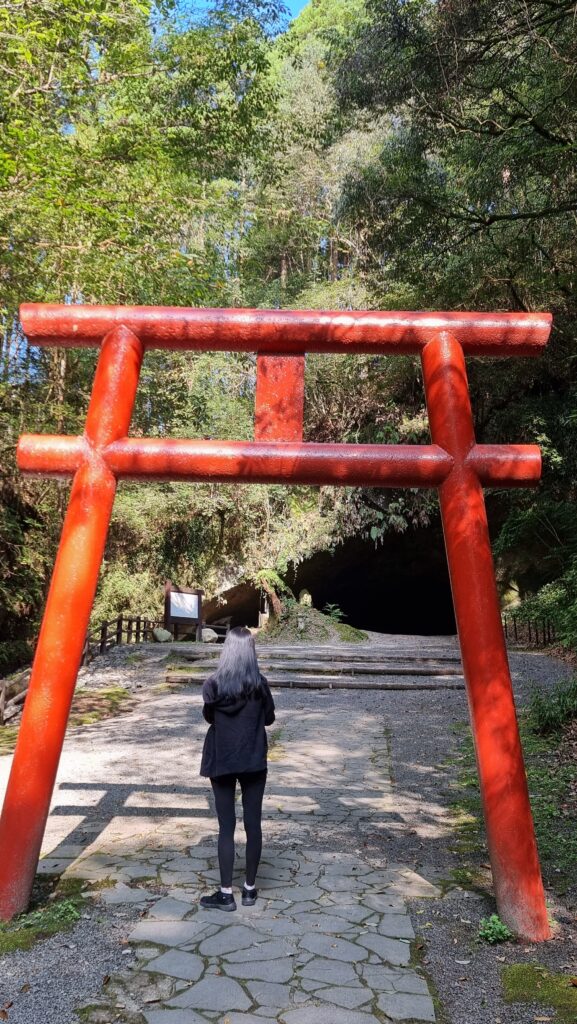
Beyond its geological wonders, Mizunokuchi Cave holds cultural significance as well. Throughout history, it has been a site of exploration and reverence, drawing curious individuals seeking a connection to the natural world. The cave’s surroundings, nestled within the Kirishima mountains, add to the overall allure, providing a serene backdrop that complements the sense of wonder inspired by Mizunokuchi Cave.
Kiriharano Falls

Located in the Chichibu-Tama-Kai National Park, Kiriharano Falls is a captivating cascade that mesmerizes visitors with its pristine waters and serene surroundings. The falls are situated in the Saitama Prefecture, offering a tranquil retreat from the hustle and bustle of urban life.

The journey to Kiriharano Falls unfolds like a poetic exploration, leading travelers through dense forests and enchanting trails that build anticipation for the breathtaking sight that awaits. As visitors approach the falls, the distant sound of rushing water heightens the senses, preparing them for the awe-inspiring spectacle that awaits.
Upon reaching the falls, one is greeted by a cascade of clear water plunging gracefully from a rocky precipice. The falls are known for their graceful descent, creating a soothing melody as the water tumbles over moss-covered rocks, adding to the enchantment of the surroundings. The lush greenery that envelops Kiriharano Falls enhances the sense of tranquility, creating a harmonious blend of nature’s elements.

Kiriharano Falls is not only a visual marvel but also holds cultural significance in Japanese folklore. The site is often associated with spiritual practices, and the surrounding area may feature shrines or sacred spaces that add a cultural layer to the natural beauty.
Sakurajima

Sakurajima, a captivating and active stratovolcano located in Kagoshima Bay, southern Kyushu, Japan, stands as both a formidable geological presence and a symbol of the country’s dynamic natural landscape. This iconic volcano, often referred to as “Cherry Blossom Island,” is situated just a few kilometers from the city of Kagoshima and is renowned for its frequent and explosive eruptions that have shaped the region’s history and culture.
The name Sakurajima, meaning “Cherry Blossom Island,” reflects the island’s seasonal beauty and the delicate contrast it provides against the backdrop of the volcano’s raw power. The surrounding landscape is adorned with cherry blossoms in spring, creating a breathtaking scene that juxtaposes the island’s serene moments with the potential for explosive volcanic activity.

Sakurajima has been an active volcano for centuries, with documented eruptions dating back to the 8th century. Its activity has significantly influenced the local way of life, leading to the development of unique customs and rituals aimed at appeasing the volcano’s powerful forces. The volcano’s ash clouds and lava flows have periodically reshaped the island’s topography, leaving a mosaic of volcanic landscapes and contributing to the rich soil that supports vibrant agriculture in the region.
Despite its active nature, Sakurajima has become a popular tourist destination, drawing visitors eager to witness the dynamic interplay between nature’s beauty and its destructive forces. The Sakurajima Visitor Center provides insights into the volcano’s history, geology, and scientific efforts to monitor and understand its behavior.
In essence, Sakurajima encapsulates the paradoxical beauty and danger inherent in nature, serving as a testament to Japan’s resilience and adaptability in the face of geological challenges. As locals and tourists alike navigate the captivating landscapes surrounding this active volcano, they are reminded of the delicate balance between the tranquility of cherry blossoms and the explosive power that lies beneath the surface.
Saraku Sand Bath Hall

Saraku Sand Bath Hall, nestled in the picturesque city of Ibusuki on the southern tip of Kyushu, Japan, is a renowned destination that offers a unique and therapeutic experience to its visitors. This extraordinary facility is distinguished by its traditional sand bathing, a practice that has been passed down through generations and is deeply rooted in Japanese culture.
The hallmark of Saraku Sand Bath Hall is its outdoor sand baths, where guests are enveloped in naturally heated volcanic sand sourced from the nearby active volcano, Mt. Kaimon. The mineral-rich sand, warmed by the geothermal activity beneath the surface, creates a soothing and relaxing environment. As visitors lie buried in the warm sands up to their necks, the heat penetrates their bodies, promoting muscle relaxation and stimulating circulation. This traditional form of therapy is believed to have various health benefits, including stress relief, improved metabolism, and skin rejuvenation.
The ambiance at Saraku Sand Bath Hall is serene and tranquil, complemented by the stunning views of Kagoshima Bay and the surrounding landscape. The facility meticulously maintains a balance between preserving the authenticity of the traditional sand bathing experience and providing modern amenities to ensure guests’ comfort.
Aside from the outdoor sand baths, Saraku Sand Bath Hall offers indoor facilities, including private baths and relaxation areas. The attentive and professional staff caters to the diverse needs of guests, ensuring a memorable and rejuvenating visit.

As a cultural gem in the heart of Ibusuki, Saraku Sand Bath Hall not only offers a therapeutic escape but also provides a glimpse into the rich heritage of Japanese wellness practices. Whether seeking relaxation, cultural immersion, or a unique spa experience, Saraku Sand Bath Hall stands as a testament to the timeless allure of traditional Japanese healing rituals in the modern world.
Cape Nagasakibana

Renowned for its breathtaking coastal landscapes, the cape offers a mesmerizing blend of rugged cliffs, pristine beaches, and panoramic ocean views, making it a must-visit destination for nature enthusiasts and history buffs alike.
The name “Nagasakibana” reflects the cape’s unique geographical features. “Nagasaki” means long cape, and “bana” translates to nose or point. True to its name, Cape Nagasakibana extends gracefully into the East China Sea, providing visitors with an uninterrupted vista of azure waters stretching to the horizon. The rugged coastline is sculpted by the relentless forces of wind and waves, creating dramatic rock formations that add to the area’s allure.
Apart from its natural beauty, Cape Nagasakibana holds historical significance deeply rooted in Japan’s past. The cape played a crucial role during the Satsuma Rebellion of 1877, a historical conflict that marked the end of the samurai era. The remnants of fortifications and lookout points from this tumultuous period can still be explored, offering visitors a glimpse into the country’s rich history.
Travelers to Cape Nagasakibana can embark on scenic coastal walks, immersing themselves in the tranquility of the surrounding nature. The observation points along the cape provide excellent opportunities for photography, allowing visitors to capture the picturesque landscapes and the meeting of sea and sky.
In addition to its natural and historical attractions, Cape Nagasakibana is a haven for birdwatchers, as the area is home to diverse bird species. The juxtaposition of cultural heritage and ecological diversity makes Cape Nagasakibana a multifaceted destination that invites exploration and contemplation.
Ryugu Shrine

Ryugu Shrine is a place of profound significance, drawing visitors and worshippers alike with its serene ambiance and ancient traditions.
The shrine’s name, “Ryugu,” translates to “Dragon Palace,” evoking a sense of mystique and mythical allure. This nomenclature reflects the deep roots of Japanese folklore, where dragons are often revered as powerful and benevolent beings. The shrine’s architecture and surroundings mirror this ethereal connection, with meticulously crafted structures adorned with intricate carvings and vibrant hues that echo the artistic finesse of traditional Japanese craftsmanship.
One of Ryugu Shrine’s distinctive features is its lush garden, a carefully manicured space that serves as a sanctuary for both spiritual reflection and quiet contemplation. Stone pathways wind through the garden, leading visitors on a symbolic journey that echoes the spiritual pilgrimage inherent in Shinto beliefs. Towering trees, vibrant flowers, and symbolic rock formations create a harmonious balance between the natural and the divine, inviting visitors to immerse themselves in the tranquility of the sacred surroundings.

The shrine is dedicated to a pantheon of Shinto deities, embodying various aspects of nature, prosperity, and protection. Pilgrims and tourists alike come to Ryugu Shrine to pay their respects, offer prayers, and seek blessings for various aspects of their lives, be it personal well-being, familial harmony, or success in endeavors.
As the seasons change, Ryugu Shrine takes on different hues, each transition marked by unique ceremonies and festivities that showcase the dynamic nature of Japanese spirituality. From cherry blossoms in spring to vibrant autumn foliage, the shrine becomes a living canvas that reflects the ebb and flow of life.
Day 5 – Kumamoto
Ryumon Falls

Tucked away in the lush greenery of the Kunisaki Peninsula, Ryumon Falls stands as a testament to the enchanting landscapes that Japan has to offer.
The falls, whose name translates to “Dragon Gate Falls,” derive their mystique from both their striking appearance and the rich cultural heritage that envelops them. The cascade descends gracefully from a considerable height, creating a mesmerizing display of water dancing over the rocky terrain. The sound of the falls, echoing through the verdant forest, adds a soothing soundtrack to the visual spectacle.
One of the distinctive features of Ryumon Falls is its association with Japanese mythology. According to local legends, the falls are believed to be a sacred site where dragons ascend to the heavens—a belief that adds an extra layer of mysticism to the already magical atmosphere. This connection to folklore has made Ryumon Falls not just a natural attraction but a cultural touchstone, drawing visitors seeking both natural beauty and a connection to Japan’s rich narrative tapestry.
The journey to Ryumon Falls is an experience in itself, as visitors traverse through lush landscapes, dense forests, and meandering paths that heighten the anticipation of the unfolding natural wonder. Along the way, visitors may encounter local flora and fauna, enhancing the immersive encounter with nature.
Takakura Viewing Platform





The Takakura Viewing Platform, nestled in the heart of the scenic landscapes of Japan, is a breathtaking vantage point that offers visitors a mesmerizing panorama of nature’s grandeur. Situated atop Takakura Hill, this platform provides an unparalleled view of the surrounding mountains, valleys, and lush greenery that define the Japanese countryside.
The platform is strategically located to showcase the beauty of the changing seasons, with cherry blossoms painting the landscape in delicate hues of pink in spring, vibrant greenery dominating the scene during summer, fiery red and orange foliage adorning the trees in autumn, and a serene blanket of snow covering the terrain in winter. Each season brings a unique charm to the Takakura Viewing Platform, making it a year-round destination for nature enthusiasts and photographers alike.
Accessible by a well-maintained trail or, in some cases, by a convenient cable car, reaching the platform is an adventure in itself. As visitors ascend, they are treated to glimpses of the diverse flora and fauna that inhabit the area, adding an extra layer of enchantment to the journey.
The Takakura Viewing Platform is not merely a visual feast; it also serves as a cultural and historical vantage point. Surrounded by ancient shrines and temples, the platform offers a contemplative space for those seeking a connection with Japan’s rich spiritual heritage. The juxtaposition of natural beauty and cultural significance makes this site a harmonious blend of the traditional and the picturesque.
Whether one seeks solitude for introspection, an opportunity to capture the perfect photograph, or simply a place to appreciate the wonders of the natural world, the Takakura Viewing Platform stands as a testament to the sublime beauty that defines Japan’s scenic landscapes. It beckons travelers to pause, breathe in the crisp mountain air, and immerse themselves in the timeless allure of this captivating vista.
Kirishima Jingu
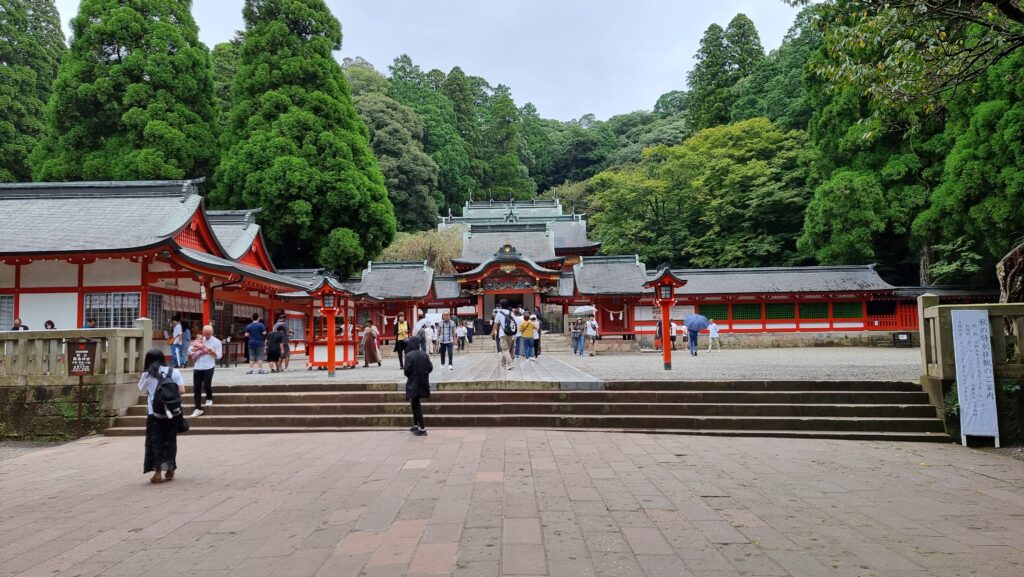
This venerable shrine, with its roots tracing back over a millennium, holds a special place in the hearts of the Japanese people and serves as a symbol of spiritual reverence.
Believed to have been established in the 6th century, Kirishima Jingu Shrine is dedicated to Ninigi-no-Mikoto, a deity from Japanese mythology who is considered one of the ancestors of the imperial family. The shrine’s sacred grounds are enveloped in a serene natural setting, surrounded by ancient cedar trees that lend an air of tranquility to the spiritual atmosphere.
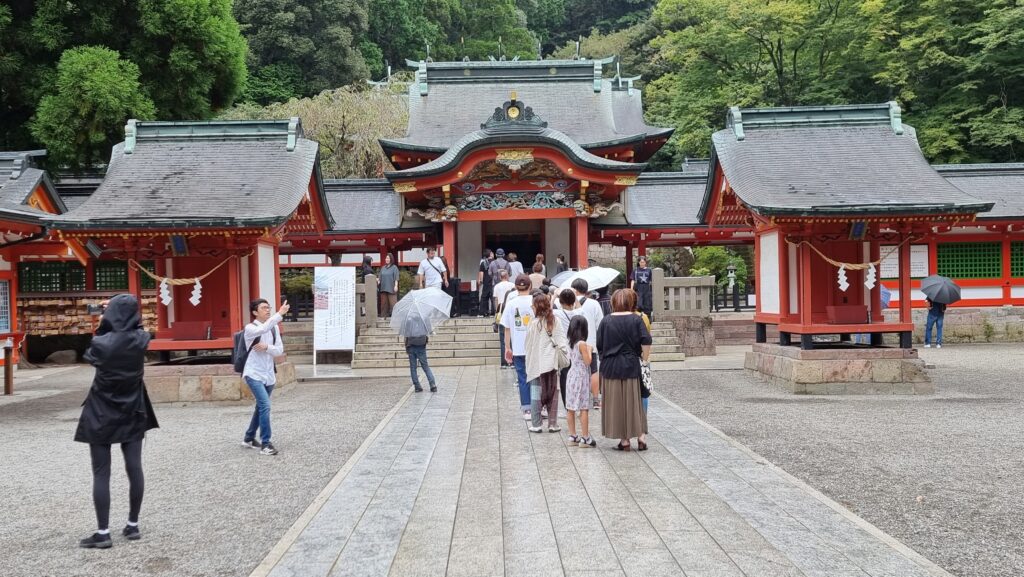
One of the shrine’s distinctive features is its architectural style, characterized by the use of hinoki cypress wood, a material traditionally associated with Shinto shrines. The main hall, or Honden, showcases the intricate craftsmanship and attention to detail that exemplifies Japanese religious architecture. Visitors are often captivated by the harmonious blend of the sacred and the natural, as the shrine seamlessly integrates into the lush greenery of the Kirishima mountains.
Throughout the year, Kirishima Jingu Shrine hosts various festivals and ceremonies, drawing pilgrims and tourists alike. The most notable among these is the Kirishima Yae Festival, held in April, during which the shrine’s grounds burst into a riot of color with vibrant cherry blossoms in full bloom. This celebration not only pays homage to the beauty of nature but also emphasizes the spiritual connection between the people and the divine.
As a place of both historical significance and natural splendor, Kirishima Jingu Shrine invites visitors to partake in a profound cultural experience, inviting them to explore the spiritual depths of Japan’s ancient traditions while surrounded by breathtaking landscapes that have inspired reverence for generations.
Takachiho Farm
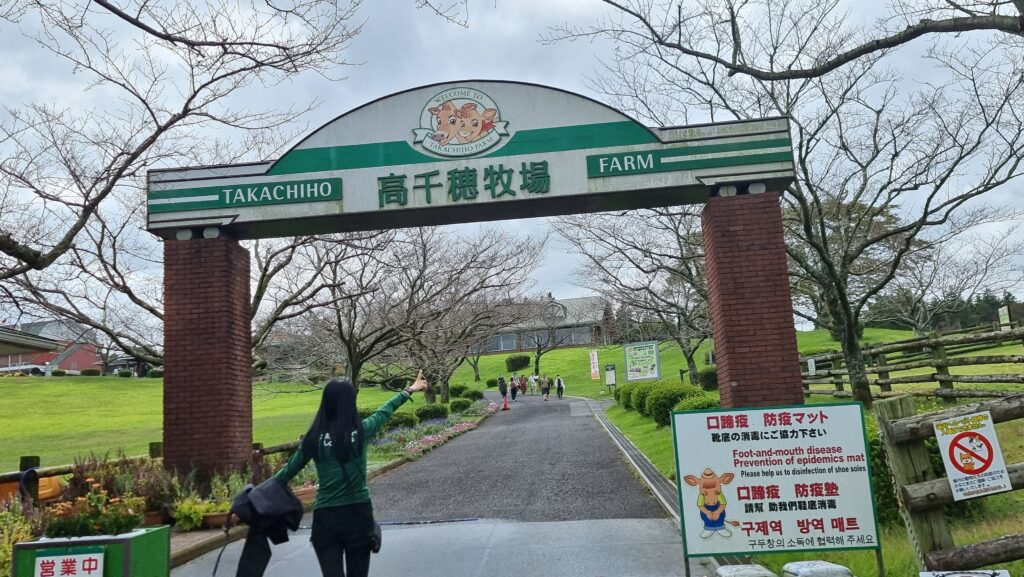
Takachiho Farm is a serene haven that seamlessly blends natural beauty with agricultural excellence. Renowned for its lush landscapes, the farm is a testament to the region’s commitment to sustainable farming practices and the preservation of traditional Japanese agriculture.
Situated in the heart of Miyazaki, Takachiho Farm benefits from the region’s fertile soil and favorable climate, creating an ideal environment for cultivating a diverse range of crops. The farm is a celebration of biodiversity, featuring expansive fields where crops like rice, vegetables, and fruits thrive in harmony. Visitors are treated to a visual feast of vibrant colors as they stroll through the meticulously maintained rows of crops, immersing themselves in the essence of rural Japan.
One of the farm’s standout features is its commitment to organic and environmentally friendly farming methods. Takachiho Farm embraces sustainable practices, eschewing harmful chemicals and pesticides in favor of natural alternatives that promote soil health and minimize ecological impact. This dedication to responsible agriculture not only ensures the production of high-quality, nutritious crops but also reflects a deep respect for the land and its delicate ecosystems.
Beyond its agricultural pursuits, Takachiho Farm offers visitors a unique opportunity to engage in hands-on experiences. From rice planting and harvesting to fruit picking, guests can actively participate in the farming process, gaining insight into the labor-intensive yet rewarding life of a Japanese farmer. These interactive activities foster a deeper connection between visitors and the land, creating lasting memories and a greater appreciation for the agricultural heritage of Miyazaki.
Takachiho-Gawara

The name “Takachiho” is often associated with the legendary founding of Japan by the gods. According to Shinto mythology, the divine couple, Izanagi and Izanami, stood on the celestial bridge Ame-no-ukihashi and stirred the ocean with a jeweled spear. As drops of saltwater fell from the tip of the spear, they formed the islands of Japan. Takachiho, said to be the landing place of these deities, is regarded as a sacred site where the gods descended to shape the world.
The prominence of Takachiho-gawara extends beyond its mythological roots. The area is renowned for its natural beauty, featuring lush green landscapes, scenic gorges, and majestic waterfalls. The Gokase River, winding through the region, adds to the picturesque charm, creating an idyllic setting that beckons nature enthusiasts and spiritual seekers alike.
At the heart of Takachiho-gawara is the Amano Iwato Shrine, a sacred Shinto shrine that holds a central role in the mythology of Japan’s creation. The shrine is dedicated to the sun goddess Amaterasu, who, according to legend, withdrew into a cave (Iwato) in response to her brother’s misdeeds, plunging the world into darkness. The Amano Iwato Shrine celebrates the dramatic re-emergence of Amaterasu and the return of light to the world.
Maruo Falls

丸尾滝 (Maruo Falls) is a captivating natural wonder nestled in the scenic landscapes of Japan. Tucked away in the lush greenery of the country, this waterfall is renowned for its breathtaking beauty and tranquil surroundings. Located in a region celebrated for its rich cultural and natural heritage, 丸尾滝 has become a popular destination for both locals and tourists seeking respite from the hustle and bustle of modern life.
The waterfall is characterized by its graceful descent, as the water cascades down a series of rocky formations, creating a mesmerizing spectacle. The sound of rushing water adds a soothing melody to the air, further enhancing the immersive experience of being in nature’s embrace. The surrounding area is adorned with vibrant flora, adding a burst of color to the landscape and providing a picturesque backdrop for visitors.
Beyond its aesthetic appeal, 丸尾滝 holds cultural significance in the hearts of those who visit. It often serves as a backdrop for traditional Japanese art and literature, symbolizing the harmonious coexistence of humanity and nature. The site has been a source of inspiration for poets and artists throughout history, contributing to its timeless allure.
Ashiyu no Eki Ebino Kogen





Nestled amidst the picturesque landscapes of Ebino Kogen in Miyazaki Prefecture, Japan, Ashiyu no Eki stands as a unique and rejuvenating destination for locals and travelers alike. Translated as “Foot Bath Station,” Ashiyu no Eki Ebino Kogen is a charming facility that combines the tranquility of nature with the therapeutic benefits of traditional Japanese foot baths.
The Ebino Kogen region is renowned for its scenic beauty, featuring lush greenery, rolling hills, and natural hot springs. Ashiyu no Eki takes full advantage of these surroundings, providing visitors with a one-of-a-kind experience to soak their feet in warm, mineral-rich waters while enjoying the breathtaking views.
The concept of “ashiyu,” or foot baths, has deep roots in Japanese culture, symbolizing relaxation and rejuvenation. Ashiyu no Eki Ebino Kogen enhances this cultural tradition by offering a variety of foot baths, each infused with local elements and unique themes. Visitors can immerse themselves in not only the soothing waters but also the rich history and heritage of the region.
Shiratori Observatory

Situated in the Shimane Prefecture, Shiratori Observatory is renowned for its strategic location, providing unobstructed views of the expansive skies above. The observatory’s elevation ensures minimal light pollution, creating an ideal environment for stargazing and astronomical observations. Visitors are treated to a celestial panorama that includes constellations, planets, and meteor showers, making it a haven for both amateur astronomers and seasoned stargazers alike.
The architectural design of the observatory is itself a work of art, seamlessly integrating with the natural surroundings. The observatory’s structure is thoughtfully crafted to minimize its impact on the environment, allowing visitors to immerse themselves in the serene beauty of the Japanese mountainscape. The observatory’s aesthetic charm is heightened during sunset and sunrise, as the changing hues of the sky complement the silhouette of the observatory, creating a breathtaking spectacle.
Beyond its celestial offerings, Shiratori Observatory also serves as an educational hub, hosting workshops, lectures, and stargazing events. Visitors have the opportunity to engage with knowledgeable astronomers who share their expertise, unraveling the mysteries of the universe in an accessible and engaging manner. The observatory’s commitment to education extends to its state-of-the-art telescopes and observation equipment, enhancing the overall experience for enthusiasts eager to explore the cosmos.
Sogi Falls Park




This enchanting waterfall is located in the Miyazaki Prefecture, on the island of Kyushu, known for its rich cultural heritage and stunning natural attractions. Sogi Falls is a hidden gem, embraced by lush greenery and steeped in the tranquility of the surrounding forests.
The falls cascade gracefully down a series of rocky cliffs, creating a mesmerizing spectacle that draws nature enthusiasts and adventurers alike. The pristine waters of Sogi Falls originate from the mountains, adding a refreshing touch to the air and providing a cool respite for those who venture to explore its vicinity. The journey to the falls is an adventure in itself, as visitors navigate through well-maintained trails, immersing themselves in the vibrant hues of the Japanese flora.
As the sunlight filters through the dense canopy overhead, it casts a warm glow on the moss-covered rocks and ferns that line the path to Sogi Falls. The symphony of chirping birds and the gentle rustle of leaves overhead create a harmonious soundtrack, enhancing the immersive experience of nature in its purest form.
Sogi Falls isn’t just a visual spectacle; it holds cultural significance for the locals, who often consider it a place of spiritual importance. The falls are surrounded by legends and stories that add an air of mystique to the already enchanting atmosphere.
Day 6 – Kumamoto
One Piece Statue
These life-sized sculptures pay homage to the immensely popular manga and anime series, “One Piece,” created by Eiichiro Oda.





Located in various parts of Kumamoto, these statues depict iconic characters from the One Piece universe, such as Monkey D. Luffy, Roronoa Zoro, Nami, and others. The statues are intricately crafted with attention to detail, capturing the essence of each character and bringing them to life for fans and visitors alike.
One of the notable locations featuring these statues is Shimada Museum of Arts, where an impressive exhibition showcases the characters against the backdrop of carefully designed sets. The museum provides an immersive experience, allowing fans to interact with the statues and relive their favorite moments from the series.





In addition to the museum, several public spaces and parks throughout Kumamoto boast their own One Piece statues. These installations contribute to the city’s vibrant atmosphere and serve as popular landmarks for both residents and tourists. The statues not only celebrate the artistic and cultural significance of “One Piece” but also foster a sense of community and shared enthusiasm among fans.
Kumamoto’s dedication to showcasing these statues reflects the global impact of “One Piece” and its ability to resonate with people of all ages. As visitors explore the city, they are invited to embark on a journey through the captivating world of pirates, treasure, and camaraderie, all embodied in the remarkable One Piece statues that have become an integral part of Kumamoto’s cultural landscape.
Those interested can refer to this link for the locations of all the statues.
Day 7 – Nagasaki
Ferry Crossing




Today we shall take our car up the ferry and cross over to Nagasaki.
Ferry crossings between Kumamoto and Nagasaki offer a picturesque journey across the scenic waters of the Ariake Sea, providing both locals and visitors with a unique and relaxing mode of transportation between these two charming Japanese cities. Situated on the islands of Kyushu, Kumamoto, and Nagasaki boasts rich historical and cultural significance, making the ferry journey not only a convenient means of travel but also an opportunity to immerse oneself in the beauty of the region.
The ferry route takes passengers across the Ariake Sea, a body of water known for its tranquil ambiance and stunning coastal landscapes. Travelers can anticipate breathtaking views of the surrounding mountains and the ever-changing seascape as they make their way between Kumamoto and Nagasaki. The journey is a perfect blend of convenience and serenity, offering a welcome break from the hustle and bustle of traditional modes of transportation.
Both Kumamoto and Nagasaki are renowned for their historical landmarks, including Kumamoto Castle and Nagasaki’s Peace Park and Atomic Bomb Museum. The ferry crossing, therefore, becomes not only a means of transport but a seamless extension of the cultural exploration that awaits visitors at their destination. The ferry service is designed to provide a comfortable and enjoyable experience, with amenities on board ensuring a pleasant journey for passengers of all ages.
Mount Unzen Disaster Memorial Hall





The Mount Unzen Disaster Memorial Hall stands as a poignant testament to one of Japan’s most catastrophic natural disasters—the eruption of Mount Unzen in 1991. Located in Shimabara City, Nagasaki Prefecture, this memorial hall serves as a somber reminder of the destructive power of volcanic activity and the resilience of communities in the face of such adversity.
The eruption of Mount Unzen in 1991 was a tragic event that claimed the lives of 43 people, including scientists, journalists, and residents who were unable to evacuate in time. The disaster was characterized by pyroclastic flows, lava flows, and ashfall, which wreaked havoc on the surrounding areas. In the aftermath, the Japanese government and local authorities undertook significant efforts to not only recover from the disaster but also to commemorate the lives lost and educate the public about volcanic risks.
The memorial hall itself is a meticulously designed structure that blends modern architecture with the natural surroundings, providing visitors with a contemplative space to reflect on the events of 1991. Inside, a wealth of exhibits, multimedia presentations, and artifacts chronicle the eruption and its aftermath. The memorial hall also serves as an educational hub, disseminating knowledge about volcanic activity, risk mitigation, and the importance of preparedness in the face of natural disasters.
Moreover, the Mount Unzen Disaster Memorial Hall stands as a symbol of resilience and community strength. It honors the memory of those who lost their lives and acknowledges the ongoing efforts to monitor and understand volcanic activity to prevent future tragedies. Through its exhibits and outreach programs, the memorial hall contributes to a broader global conversation on disaster preparedness and the delicate balance between human settlement and the powerful forces of nature. Visiting this memorial is not only a sobering experience but also an opportunity to appreciate the indomitable human spirit in the face of nature’s fury.
Shimabara Bukeyashiki (Samurai residence)





The term “Bukeyashiki” refers to a samurai residence or the compound where samurai families lived. In the case of Shimabara, the bukeyashiki reflects the architectural and cultural heritage of the samurai who served the local domain. The structures embody the ideals of samurai living, characterized by a harmonious blend of functionality, simplicity, and aesthetic refinement.
What sets Shimabara Bukeyashiki apart is its picturesque setting against the backdrop of Shimabara Castle, a strategic fortress that played a significant role in the history of the region. The bukeyashiki itself consists of well-preserved traditional houses, complete with elegant tatami rooms, sliding paper doors, and meticulously landscaped gardens. Visitors can wander through these historic dwellings, gaining insights into the daily routines, customs, and rituals that define samurai life.
Beyond the architectural marvels, Shimabara Bukeyashiki serves as a living museum, offering various exhibits and demonstrations that showcase the martial arts, weaponry, and cultural practices of the samurai. The site aims to transport visitors back in time, fostering an immersive experience that educates and entertains.
Shimabara Bukeyashiki serves as a cultural treasure, providing a tangible link to Japan’s feudal past. Its preservation and accessibility contribute to the appreciation and understanding of the samurai legacy, ensuring that this vital aspect of Japanese history is for future generations to explore and appreciate.
Unzen Amakusa National Park – Nita Pass
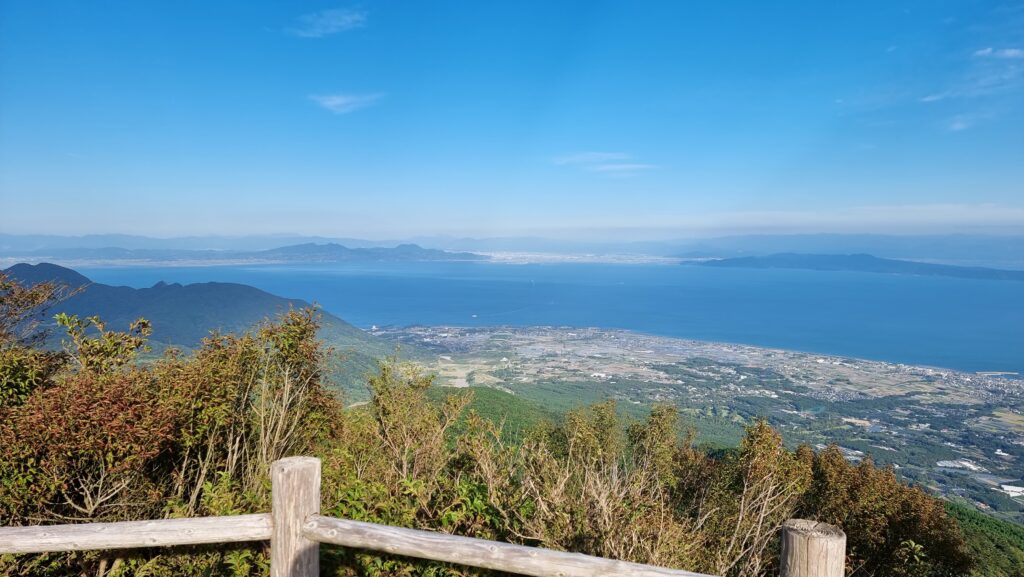
Encompassing the iconic Unzen volcanic region and the picturesque Amakusa Islands, the park is a testament to the dynamic forces that have shaped the Japanese landscape.
At the heart of the park lies the Unzen volcanic area, renowned for its dramatic scenery and geothermal activity. Dominated by Mount Unzen, an active stratovolcano, the landscape is characterized by rugged terrain, hot springs, and fumaroles. Visitors can explore a network of hiking trails that offer breathtaking views of volcanic craters and steaming vents. The volcanic activity in the region has left its mark on the landscape, creating a unique and otherworldly environment.
Amakusa, a chain of islands nestled in the East China Sea, complements the volcanic spectacle of Unzen. Known for its pristine beaches, coastal cliffs, and lush greenery, Amakusa provides a stark contrast to the fiery forces at play in the neighboring volcanic region. The islands are not only a haven for nature enthusiasts but also harbor a rich cultural history, with ties to the hidden Christians of Japan’s past.
The park’s diverse ecosystems support a variety of flora and fauna, making it a haven for biodiversity. From alpine plants on the slopes of Mount Unzen to coastal marine life around the Amakusa Islands, the park offers a wide range of habitats for exploration. Birdwatchers, in particular, can revel in the opportunity to spot a variety of avian species that call the park home.
In addition to its natural splendors, Unzen Amakusa National Park is a cultural treasure trove. The Amakusa Islands, historically associated with the clandestine practice of Christianity during Japan’s isolation period, boast hidden churches and artifacts that tell a compelling story of resilience and faith.
Unzen Jigoku





Day 8 – Nagasaki
Hot foot 105





Situated in the hot spring resort town of Obama on Tachibana Bay, you will find the longest ashiyu in Japan and also the hottest.
Hot Foot 105 is 105 meters long and the water temperature is 105 degrees F. Best of all, it’s FREE!!!!!.
Meganbashi Bridge

Meganebashi, also known as the “Spectacles Bridge,” is a historic stone bridge located in Nagasaki, Japan. The bridge is renowned for its unique double-arch design, which gives it the appearance of a pair of spectacles, hence the name.
Key features of Meganebashi Bridge include:
- Architecture: The bridge was constructed during the Edo period (1603-1868) using stone, and it features two distinctive arches. The arches are not symmetrical, contributing to the bridge’s charming and somewhat quirky appearance.
- Historical Significance: Meganebashi is one of the oldest stone arch bridges in Japan, dating back to 1634. It has survived various natural disasters and has become a symbol of Nagasaki’s historical heritage.
- Location: The bridge spans the Nakashima River, connecting the neighborhoods of Meganebashi and Hamaguribashi. Its location provides a picturesque view of the surrounding area, and the bridge is often featured in tourist guides and postcards.
- Cultural Importance: Meganebashi is a designated Important Cultural Property of Japan, recognizing its historical and cultural significance. Visitors to Nagasaki often include the bridge as part of their sightseeing itinerary.
- Surrounding Area: The area around Meganebashi features traditional Japanese architecture and is a popular spot for walking and exploring the historic charm of Nagasaki.
When visiting Nagasaki, Meganebashi Bridge is a notable landmark to explore, offering a glimpse into Japan’s architectural and historical past. It’s not only a functional bridge but also a cultural icon that adds to the unique character of Nagasaki.
Nagasaki Shinchi Chinatown

Here are some key points about Nagasaki Shinchi Chinatown:
- Historical Significance: Nagasaki has a long history of foreign influence, particularly from China and Portugal. The city was one of the few open to foreign trade during Japan’s period of isolation (Sakoku). Shinchi Chinatown is a reflection of the Chinese influence on Nagasaki’s culture and cuisine.
- Oldest Chinatown in Japan: Nagasaki Shinchi Chinatown is considered the oldest Chinatown in Japan. It has a history dating back to the 17th century when Chinese traders and sailors settled in the area.
- Architectural Style: The architecture in Nagasaki Shinchi Chinatown reflects traditional Chinese designs with vibrant colors and intricate decorations. The area is characterized by narrow streets, lined with traditional Chinese-style buildings housing restaurants, shops, and other businesses.
- Cuisine: One of the main attractions of Shinchi Chinatown is its diverse and delicious cuisine. Visitors can enjoy a variety of Chinese dishes, including dim sum, ramen, and other regional specialties. Many restaurants in the area have a long history and are known for preserving traditional recipes.
- Landmarks and Temples: Within Shinchi Chinatown, you can find several notable landmarks and temples. One such example is the Kanteibyo, also known as the Confucius Shrine, which is a Chinese-style temple dedicated to Confucius.
- Cultural Events: The Chinatown is a lively area that hosts various cultural events and celebrations, especially during Chinese festivals like Chinese New Year. These events often feature traditional performances, parades, and other festivities.
- Shopping: Nagasaki Shinchi Chinatown is a great place for shopping, offering a variety of Chinese goods, souvenirs, and unique items that reflect the cultural fusion of the area.
Mount Inasa
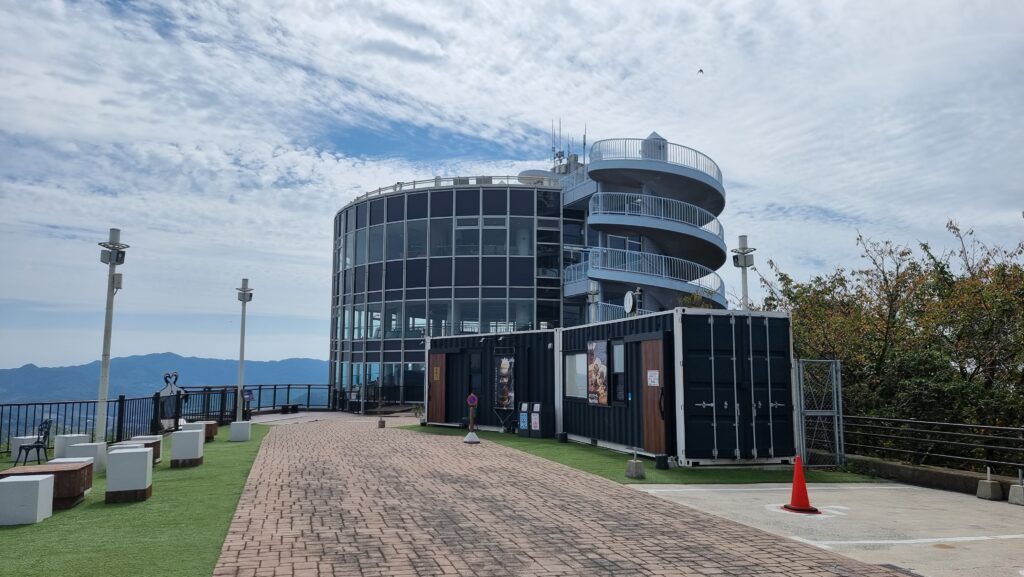
Mount Inasa, also known as Inasayama, is a prominent mountain located in Nagasaki, Japan. Rising 333 meters above sea level, Mount Inasa offers breathtaking panoramic views of Nagasaki and its surrounding landscapes. The mountain is renowned for its observation deck, which provides one of the most spectacular night views in the world.

The Inasayama Observation Deck, situated at the mountain’s summit, offers a 360-degree view of Nagasaki City, its harbor, and the surrounding islands. The city’s lights shimmer below, creating a mesmerizing scene that attracts visitors from far and wide. The observation deck is particularly popular in the evening, as it provides an unforgettable experience of Nagasaki illuminated against the backdrop of the night sky.

Access to Mount Inasa is facilitated by various means, including a ropeway and a road that allows visitors to drive or hike to the summit. The ropeway, known as the Nagasaki Ropeway, is a convenient and scenic way to reach the top, offering stunning views during the ascent.
In addition to its spectacular night views, Mount Inasa is also a popular destination for nature enthusiasts and hikers. The mountain is surrounded by lush greenery, and there are hiking trails leading to the summit for those who prefer a more active approach to enjoying the scenery.
Overall, Mount Inasa is not only a natural landmark but also a cultural and tourist attraction, drawing people with its stunning vistas, accessibility, and the unique experience of witnessing Nagasaki from a vantage point that captures the city’s beauty in both daylight and nighttime settings.
Sanno Shrine one-legged Torii Gate

The Sanno Shrine, which was situated about 800 m from the center of the Atomic blast in the 2nd World War, was obliterated by the explosion and the 4000°C heat wave. Many parts of the Shrine and nearby trees were vaporized. A Torii arch standing on a single pillar remains.
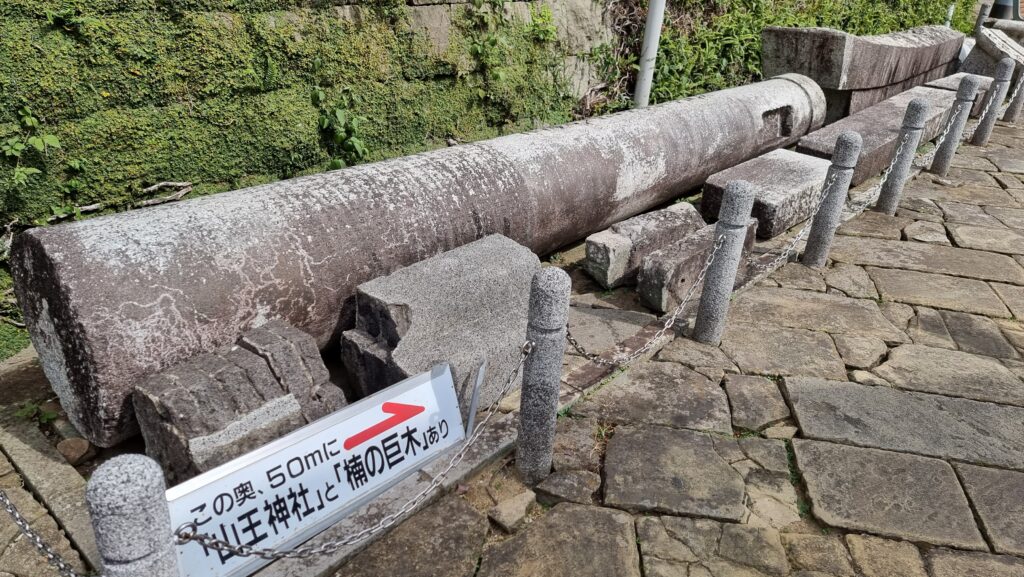
The people in Nagasaki call this gate “One-legged Torii”.
And the remains of the destroyed half part are displayed near this Torii.
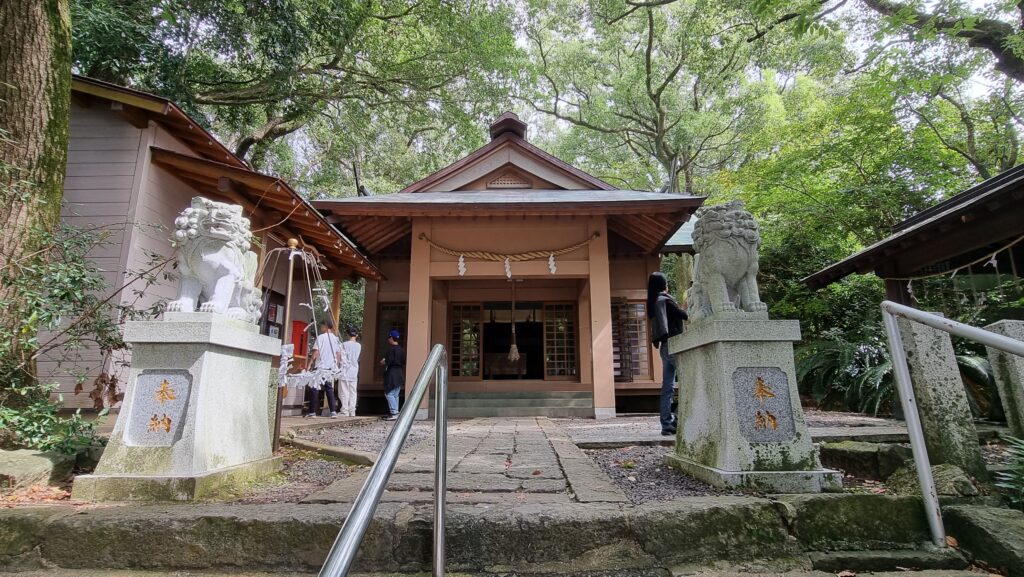
A new Shrine was built about 50m from the one-legged Torii Gate.
Nagasaki Peace Park

Nagasaki Peace Park, located in Nagasaki, Japan, is a poignant memorial dedicated to the memory of the victims of the atomic bombing that took place on August 9, 1945, during World War II. The park serves as a powerful symbol of peace, reconciliation, and the pursuit of a world free from nuclear weapons.

At the heart of the Nagasaki Peace Park is the Peace Statue, a prominent and iconic symbol designed by sculptor Seibou Kitamura. The statue depicts a man with one arm pointing to the sky as a symbol of the threat of nuclear weapons and the other extended horizontally representing eternal peace. The raised face with closed eyes reflects a silent prayer for the souls of the deceased.

The park also features a memorial fountain and a pond, which together create a tranquil atmosphere for contemplation. The Fountain of Peace, in particular, is designed to console the souls of the victims by providing water, a symbol of life, to the deceased.
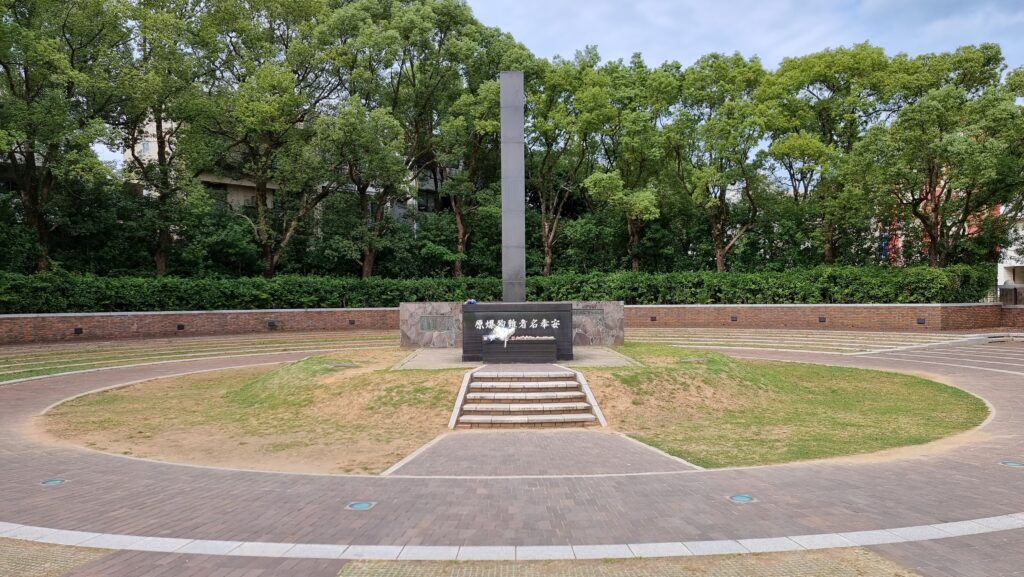
Nearby, the Hypocenter Park marks the exact spot above which the atomic bomb exploded. Visitors can see a black monolith that indicates the hypocenter and read information about the devastating impact of the bombing on the city and its residents.
Nagasaki Peace Park stands as a reminder of the devastating consequences of nuclear warfare and serves as a call for global peace and disarmament. The site attracts visitors from around the world who come to pay their respects, reflect on the tragedy of war, and promote a future free from the threat of nuclear weapons. The park plays a crucial role in preserving the memory of the victims and fostering a commitment to building a more peaceful world.
Floating Torri Gate of Ouuo Shrine

Torii gates are traditional Japanese gates commonly found at the entrance of Shinto shrines. They symbolize the transition from the mundane to the sacred. The gate’s two upright posts and two crossbars are often painted in vermilion red, a color believed to ward off evil spirits.
The “Floating Torii Gate” of Ouuo Shrine stands on the shallow area of the ocean in Tara-cho. During high tides, it appears to be floating on the water. It is a famous tourist spot.
Day 9 – Fukuoka
Kurume Castle Ruins

Kurume Castle Ruins, located in Kurume City, Fukuoka Prefecture, Japan, holds a rich historical significance as remnants of a once-majestic castle complex. The castle was originally constructed in the early 17th century, during the Edo period, by Hosokawa Tadaoki, a prominent feudal lord. The castle served as a strategic military stronghold and a symbol of power in the region.

Kurume Castle was known for its formidable defenses and strategic location, situated atop a hill to provide a commanding view of the surrounding landscape. The castle grounds encompassed various structures, including a central keep, gates, towers, and walls, creating a formidable complex that played a crucial role in local governance and defense during its heyday.
Despite its historical significance, Kurume Castle faced a tumultuous history, including damage from fires and battles. Ultimately, in the late 19th century, during the Meiji Restoration, an era marked by significant political and social changes in Japan, many castles, including Kurume Castle, were dismantled as part of the government’s policy to eliminate symbols of feudalism.

Today, the Kurume Castle Ruins stand as a testament to the region’s historical past. Visitors can explore the remains of the castle’s foundations, stone walls, and gates, gaining insights into the architectural prowess and strategic planning of the Edo period. The site offers a picturesque setting with scenic views, providing a tranquil environment for reflection on Japan’s feudal history.
As with many castle ruins in Japan, efforts have been made to preserve and showcase the historical significance of Kurume Castle. Interpretative signs and exhibits may be present, providing additional context for visitors interested in delving deeper into the castle’s history. The site serves not only as a historical attraction but also as a cultural heritage site, connecting present-day visitors to the rich tapestry of Japan’s feudal past.
Daihonzan Naritasan Kurume Temple

Standing 62 meters (203 feet) tall, the statue of the Affectionate Mother Kannon is the largest such statue in Japan. It can be seen from miles around due to its towering height and shimmering white appearance
The temple was founded in 1958 and it attracted many visitors over the years.

A spiral staircase was built inside the statue of Kannon that allows visitors to climb up and enjoy panoramic views of southern Fukuoka Prefecture. This feature provides visitors with a breathtaking experience and a chance to appreciate the beauty of the surrounding areas.
Tosu Premium Outlet

Tosu Premium Outlet, located in the charming city of Saga, is a premier shopping destination that caters to the discerning tastes of both locals and tourists alike. Renowned for its upscale shopping experience, this outlet center offers a unique blend of high-end fashion, luxury brands, and diverse retail options, all set against the backdrop of Saga’s scenic landscapes.

Key Features:
- Luxurious Brand Selection: Tosu Premium Outlet boasts an impressive collection of renowned international and domestic brands. From fashion and accessories to home goods and electronics, the outlet is a haven for those seeking quality and style.
- Scenic Location: Situated in Saga, the outlet benefits from the region’s picturesque surroundings. Visitors can enjoy a leisurely shopping experience amidst the beauty of Saga’s landscapes, making it not just a retail destination but a delightful retreat.
- Dining and Entertainment: Beyond shopping, Tosu Premium Outlet offers a diverse range of dining options, from casual cafes to upscale restaurants. Visitors can take a break, indulge in culinary delights, and enjoy a vibrant atmosphere. Additionally, the outlet may feature entertainment options to enhance the overall visitor experience.
- Seasonal Events and Promotions: Tosu Premium Outlet often hosts seasonal events and promotions, attracting shoppers with special discounts, exclusive offers, and engaging activities. These events add a dynamic element to the shopping experience, making each visit unique.
That’s all for the time being. There are of course many other interesting places to visit in Kyushu that were not included in this due to the time available. When I revisit Kyushu in the near future, I will update the post. Meanwhile, have a good trip!!!!!!!!!!!
Related Post:
Disclosure: This post contains affiliate links. If you buy something through them, I will receive a small commission at no additional cost to you. Thank you for your support.
